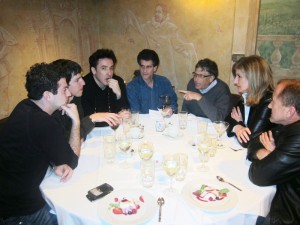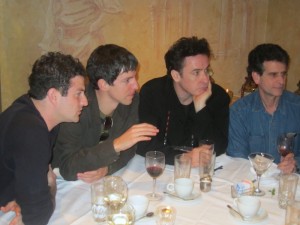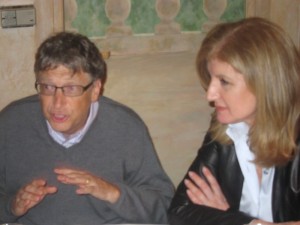
left to right: Jared Cohen, Dave Morin, John Cusack, Dean Kamen, Bill Gates, Arianna Huffington, Michael Shermer. (All photos in this post were taken by John Brockman.)
No, it wasn’t exactly My Dinner with Andre—the classic 1981 filmed conversation between Wallace Shaun and Andre Gregory (directed by Louis Malle) that ranged across a diversity of existential topics—but listening to Bill Gates hold forth on matters of business, economics, finance, world health, education, and nutrition and physical fitness in a dinner arranged by John Brockman’s Edge.org during last week’s TED gathering in Long Beach was a memorable experience nonetheless.
Richard Dawkins once said that John Brockman has the most stellar rolodex in all of science, and periodically Brockman organizes an Edge.org event that brings them all together for some serious dialogue about the great issues of our time. There were around 80 people in all, which soon broke up into small groups of schmoozing and social networking. Check out the roster and accompanying photos.
When it was time to sit down for dinner there was a spot open at the Gates table (we’ll call it), that included some heavyweights such as Facebook’s Dave Morin, the Segway inventor Dean Kamen, the actor John Cusack, Jared Cohen from the U.S. State Department, Michael Tchao, VP of Apple’s new iPad division, Arianna Huffington of HuffingtonPost, Bill Gates, and your humble servant.
This was unlike any dinner I’ve ever attended. Usually no matter how many heavyweight bigshot superstars are present there always seems to be a relatively fluid conversation around the table that unfolds organically as different people make different contributions. Not so here. Bill Gates was the star and we were tiny planets in orbit around him, sitting there like acolytes at the feet of the guru, asking him questions and listening to his lengthy and thoughtful answers. You can see it in the faces of the guests in the second photo, oriented toward Gates who is just off camera to the right, as Gates (in the third photo) offers his thoughts on the various queries put to him. (All photos by John Brockman. See the entire set.)

left to right: Jared Cohen, Dave Morin, John Cusack, Dean Kamen
Seriously, this was one weird dinner. After spending two hours at this table I can honestly say that I haven’t any idea what the other folks sitting there are like. The actor John Cusack, for example, strikes me as a thoughtful and intelligent man, but I never got to talk to him because there was next to no other conversations. Ditto the others, although Arianna did unlock her Gate-gaze long enough to give me one of her business cards, encouraging me to blog about the dinner at HuffPo (but I’m committed to True/Slant now even though I occasionally hop over to her mostly-liberal site to give them a dose of my libertarian bias).
I knew Bill Gates was smart, but in my estimation after listening to him for two hours is that he is really smart, off-the-charts smart, super bright, even brilliant. He is obviously well-read on those matters important to him, and he seems to have a steel-trap memory for regurgitating what he has read in great detail. Discussing world health and nutrition led me to ask him about diets and health and what he does personally, to which he answered that he runs 90 minutes a day on a treadmill. Since I do a fair amount of exercise myself (cycling is my poison) I asked him if he listens to audio books, which he said he does but is especially keen on listening to Teaching Company courses while working out, most especially the economics courses taught by Professor Timothy Taylor. Since I have taken all of these courses myself (you can download them into an iPhone and listen to them while driving, cycling, running, hiking, etc.), it was interesting to listen to Gates reiterate what was in them in the course of the evening as we asked him questions about the economy. I could tell that he could call forth from memory intricate details from those courses but in a completely different context in answer to a separate question.

Bill Gates and Arianna Huffington
I asked Gates “Isn’t it a myth that some companies are ‘too big to fail’? What would have happened if the government just let AIG and the others collapse.” Gates’ answer: “Apocalypse.” He then expanded on that, explaining that after talking to his “good friend Warren” (Buffet), he came to the conclusion that the consequences down the line of not bailing out these giant banks would have left the entire world economy in tatters.
Arianna Huffington asked Gates about Obama’s various jobs programs to stimulate the economy. Gates answered: “Let me tell you about what leads companies to create more jobs: demand for their products. My friend Warren owns the world’s largest carpet manufacturing company. Their business has dried up because the demand for carpets has declined dramatically due to the drop off in the construction of new homes and office buildings. If you want to create more jobs you need to create more demand for products that the jobs are created to fulfill. You can’t just make up jobs without a real demand for them.” I believe that was the last thing Arianna said for the evening.
This led me to ask Gates this: “If the market is so good at determining jobs and wages and prices, why not let the market determine the price of money? Why do we need the Fed?” Gates responded: “You sound like Ron Paul! We need the Fed to steer the economy away from extremes of inflation and deflation.” He then schooled us with a mini-lecture on the history of economics (again, probably gleaned from Timothy Taylor’s marvelous course for the Teaching Company on the economy history of the United States) to demonstrate what happens when fluctuations in the price of money (interest rates, etc) swing too wildly. I believe that was the last question I asked Gates for the evening! What do I know? I run a tiny nonprofit science education organization with six employees. I’m just hoping to be able to cover my daughter’s college tuition next year. Gates is the world’s richest man who founded a giant multi-national corporation and heads a powerful nonprofit organization that is trying to save the third world. He surely understands economics and business and finance better than I do, right? I sure hope so!
Anyway, thanks to Edge.org for a splendid evening that resulted in a handful of people getting schooled in finance by the smartest guy in the room. Let’s hope he’s right about the bailout and that the economic apocalypse is behind us.






